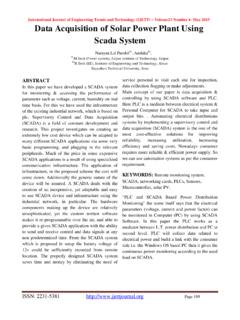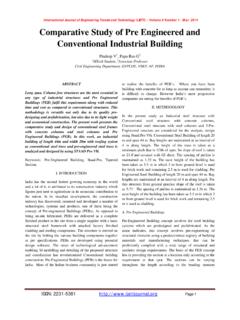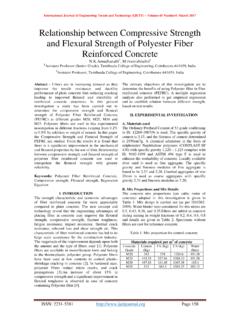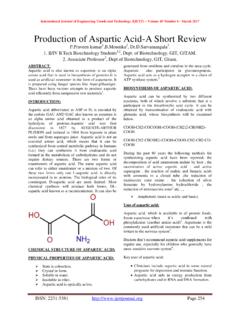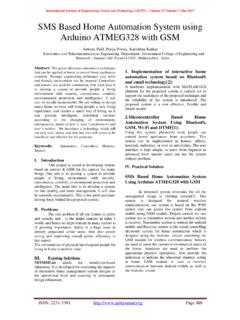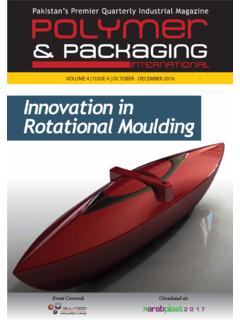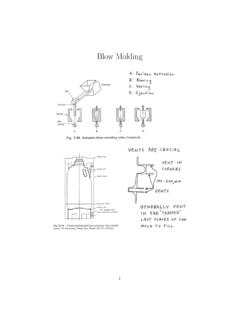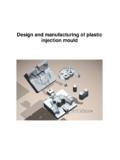Transcription of Volume22 Number 5- April 2015 Implementation of FMEA in ...
1 International Journal of Engineering Trends and Technology (IJETT) Volume22 Number 5- April 2015 ISSN: 2231-5381 Page 230 Implementation of FMEA in injection Moulding Process Shivakumar K M1, Hanumantharaya R2, Mahadev U M 3 Kiran prakasha A 1243#Assistant professor Department of Mechanical Engineering, Sahyadri College of engineering, VTU, Karnataka Abstract- FMEA is set of guiding principle for identifying and prioritizing the probable failures or defects. It is focused on preventing problems, enhancing safety, and rising customer satisfaction. This Project was carried out to determine the risk associated with defects in the injection moulding process using FMEA method and reduce the defects to ensure that the same kind of defects should not arise in the future.
2 Thereby reducing the total cost of production and increasing customer fulfilment. Keywords FMEA, Occurance, seviarity, detection, RPN 1. INTRODUCTION FMEA is set of guidelines for identifying and prioritizing the major defects. It is focused on preventing problems, increasing safety, and increasing customer satisfaction. Usually, FMEA s are conducted in the product design or process development stages, conducting an FMEA on existing products or processes may also yield benefits Failure Mode and Effect Analysis (FMEA) was first developed as a formal design methodology in the 1960s by the aerospace industry with their noticeable reliability and safety requirements. The FMEA is used to analyse concepts in the early stages before hardware is defined (most often at system and subsystem).
3 It focuses on major failure modes linked with the proposed functions of a concept proposal. The cause and effect diagram is used to discover all the possible or real causes (or inputs) that result in a single effect (or output) (1). Causes are set according to their level of significance, resulting in a portrayal of relationships and hierarchy of events. This can help us to search for root causes, identify areas where there may be problems, and compare the relative importance of different causes. Later, its use spread to other industries, such as the oil, automotive and natural gas. FMEA aims to recognize and prioritize possible imperfections in products and processes. FMEA (1) analyses potential failure modes, main effects, main causes, assesses current process controls and determines a risk priority factor.
4 FMEA to be effectual, the FMEA must be iterative to correspond with the nature of the design process itself. The extent of effort and complication of approach used in the FMEA will be dependent upon the nature and requirements of the individual program. Fig: 1 flow chart of FMEA 2. FMEA VARIABLES Severity of effect (S):- Severity measures the seriousness of the effects of a failure mode. Severity categories are estimated using a 1 to 10 scale. Probability of occurrence(O):- Occurrence is related to the probability of the failure mode and cause. Detection (D):- The assessment of the ability of the designcontrols to identify a potential cause. Detection of preforms are generated on the basis of likelihood of detection by the relevant company design review, testing programs, or quality control measures.
5 Risk Priority Number (RPN):- The Risk Priority Number is the product of the Severity (S), Occurrence (O), and Detection (D) ranking. The RPN is a measure of design risk and will compute between 1 and 1000. 3. DATA COLLECTION Before design and Implementation of FMEA to preform making process it is required to have careful knowledge of the process, therefore the same is studied by using process flow chart. The first phase of the work was to collect the preform rejection data, information about preforms, preform making International Journal of Engineering Trends and Technology (IJETT) Volume22 Number 5- April 2015 ISSN: 2231-5381 Page 231 machines through visits to the production plant. Percent average preform rejection of one month is gathered from QC reports and the most common problems due to which preforms are rejected are noted before the start of the study.
6 A. Rejection Data: Rejection of water bottle preforms has been collected from the Transparent Polymers Ltd. Hubli. Sr. No Problem Description Quantity Rejected Per month Loss 1 Material Degradation 15,840 39,600 2 Bubble 12,960 32,400 3 Short neck 6,240 15,600 4 Black Spot 4,800 12,000 5 WhitePreform 3,840 9,600 6 Flask 3,120 7,200 7 Silver stake 1,440 3,600 Total = 1,20,000 Rs Table:1 Rejection data of defect preforms before implementing FMEA Problem Description % Rejection Cumulative% 1 Material Degradation 33 33 2 Bubble 27 60 3 Short neck 13 73 4 Black Spot 10 83 5 White Preform 8 91 6 Flask 6 97 7 Silver stake 3 100 Table:2 Cumulative percentage of Rejection of Defects B.
7 Pareto Diagram: The above graph shows the percentage rejection of defects and also cumulative percentage of defects. According to FMEA we are going to concentrate 80% of defects first. By above graph we can easily analyze how much defects come under 80 percent. So let us going to find solutions for defects Material Degradation, Bubble, Short neck, Black spot & white perform. After finding solution for these defects we can go for the defects Flask & Silver stake. 4. ANALYSIS OF DATA Once the preform rejection data is gathered the areas where concentration is required are finalized so that the rejection of preforms will come down. Accordingly efforts have been put to reduce the rejection. I started analysis of the data to identify causes of occurrence of each problem and effects of these problems on quality characteristics of the preforms.
8 Once I obtained all the information available about the problems of preform rejection or potential failures of the preform making process, it moved the operative phase of risk evaluation through definition of the FMEA form. The form used in this work is based on the reference manual. The form reported the detected rejection typologies and some additional information associated with them: potential causes, failure effects that detect the failures, evaluation of three risk parameters and calculation of RPN of each cause of the 336073839197100020406080100120% Rejection Cumulative % International Journal of Engineering Trends and Technology (IJETT) Volume22 Number 5- April 2015 ISSN: 2231-5381 Page 232 problem.
9 The evaluation of the three risk parameters is done on the numerical scale defined by the FMEA team created on the basis of reference manual. The numerical scales are shown in the table. They are based on the needs of the high pressure molding line of the company or final product. The cause having higher RPN is given priority. Finding of RPN involves 3 steps. Occurrence Evaluation Criteria Severity Evaluation Criteria Detection Evaluation Criteria RPN = (Occurrence Evaluation Criteria)*(Seviority Evaluation Criteria)*(Detection) Evaluation Criteria) Occurrence Evaluation Criteria The probability that a failure will occur during the expected life of the system can be described in potential occurrences per unit time. Individual failure mode probabilities are grouped into distinct, logically defined levels.
10 Probability of failure Likely failure rates Occurrence Very high 100/1000 10 50/1000 9 High 20/1000 8 10/1000 7 Moderate 5/10000 6 2/10000 5 Low 1/1000 4 3 2 Remote 1 Table:3 FMEA Occurrence Evaluation Criteria Severity Ranking Criteria Calculating the severity levels provides for a classification ranking that encompasses safety, production continuity, scrap loss, etc. There could be other factors to consider (contributors to the overall severity of the event being analyzed). Table :4 Severity Ranking Criteria Detection Evaluation Criteria This section provides a ranking based on an assessment of the probability that the failure mode will be detected given the controls that are in place.

